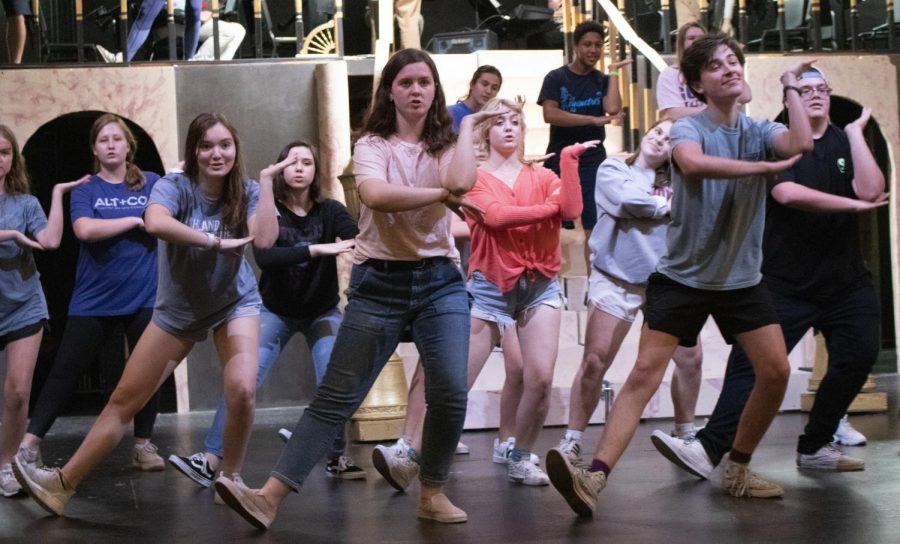The theater department tackled the longest running show on Broadway with its first production of the year, “The Phantom of the Opera.”
Directed by theater teacher Christine Hathcock, the iconic musical features senior William Jackman as the Phantom and senior Karen Shirley as Christine, a young chorus girl.
“Whenever you’re choosing a play, you really have to know the limits of your people – of your cast and your crew,” Hathcock said. “I felt very confident that we would be able to do [the show] successfully.”
While Hathcock’s confidence in her students was high, the musical required a demanding amount of preparation – from both the cast and crew – due to the extraordinary attention to detail in the set, costumes and performance logistics.
For starters, the stage is taken up by an elaborate grand staircase that opens up to the Phantom’s lair. It’s painted gold and black, with small flecks of red, and meticulously assembled railings. At the top of the stairs is a platform large enough to hold the 17-member orchestra.
Additionally, the stairs move. Because the stairs open up multiple times during the show, two people had to be behind them to open and move it, and the entire cast took time off from rehearsal to learn how to move the stairs properly.
“The set is extravagant,” freshman Emma Becker said, a member of the cast. “You build it yourself. It’s all hands on.”
The set was was built by the crew, which consisted of stage manager Callie Seabolt, assistant stage manager William Day and technical crew member Tori Ewes. First-year tech director Tyler. Perring oversaw the set’s build.
“Mr. Perring is a super hard worker, and he’s super nice,” Becker said. “He was also very helpful teaching us how to use power tools,” she said.
The entire cast also took an extra two days off of rehearsing just to help construct and paint the sets.
“We had work days pretty much every weekend from about 10 to 4 some days,” Shirley said. “Not all of us would have to come, but all of us are required to have six service hours, so we built the set or helped with props.”
Viewers will also notice a large gold chandelier hanging from a curtain rod. There are a few times during show where this chandelier, controlled by the tech team, drops down to the stage. This is meant to scare the audience into thinking the chandelier is actually falling. The tech team was also in charge of the special effects, such as the fog machine that fills the stage whenever the Phantom appears.
“I think [the fog machine] is really cool,” freshman Greer Manley said. “I have never worked with one, and man, it gets foggy backstage, but it looks cool,” she said.
The set wasn’t the only part of the show demanding extra attention to detail. Because the show is set in 1912 France, the costumes were specific to that era, creating a need for dramatic apparel. The female members of the cast wear colorful dresses that have large skirts and are decorated with intricate designs. Hathcock said the costumes were the most challenging part of the entire musical.
“I started building costumes in May, and I continued to work up until the moment we opened,” Hathcock said.
Rehearsals also placed a large time demand on cast members and crew. They began on August 7 and usually ran from 3:30 until 6:30 p.m. every day. However, as the show got closer, rehearsals ended as late as 10:30 p.m.
“I’m not going to lie, keeping up with my homework [was hard], but with everyone who’s helped me it’s been a little easier on me,” Manley said.
The long hours spent building the set, creating costumes and rehearsing the play were showcased during opening weekend Sept. 21. The last chance to see “The Phantom of the Opera” will be in the Palmer Auditorium on Sept. 28 and 29, and tickets will sell for $10 for students and $15 for general admission.
“I love watching the growth of the cast and crew and seeing the success on their faces when they know they got something really well done,” Hathcock said. “When they hit their mark and everything goes the way that it’s supposed to go, they get goosebumps, and the audience gets goosebumps, and you feel the electricity.”




